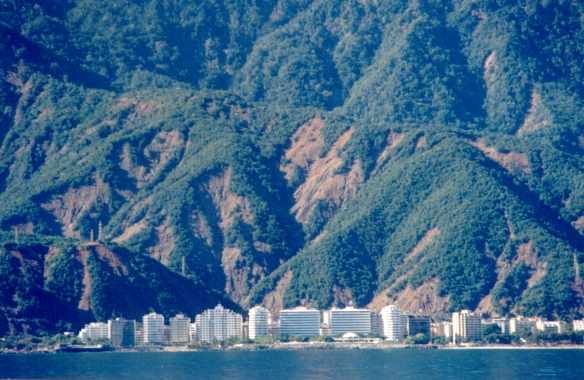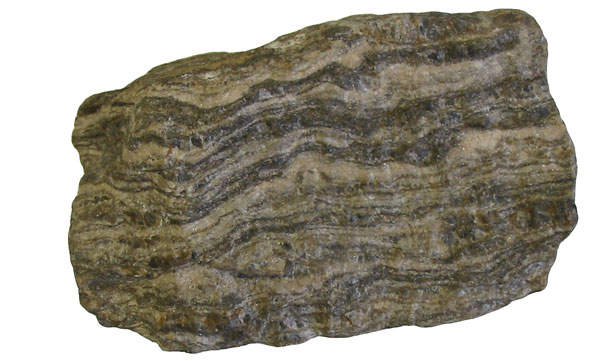|
1999 Vargas Mudslides
The Vargas tragedy was a natural disaster that occurred in Vargas State, Venezuela on 14–16 December 1999, when torrential rains caused flash floods and debris flows that killed tens of thousands of people, destroyed thousands of homes, and led to the complete collapse of the state's infrastructure. According to relief workers, the neighborhood of Los Corales was buried under of mud and a high percentage of homes were simply swept into the ocean. Entire towns including Cerro Grande and Carmen de Uria completely disappeared. As much as 10% of the population of Vargas died during the event. Background The coastal area of Vargas State has long been subject to mudslides and flooding. Deposits preserved on the alluvial fan deltas here show that geologically similar catastrophes have occurred with regularity since prehistoric times. Since the 17th century, at least two large-magnitude debris flow, landslide, or flood events, on average, have occurred each century within the modern ... [...More Info...] [...Related Items...] OR: [Wikipedia] [Google] [Baidu] |
Foliation (geology)
Foliation in geology refers to repetitive layering in metamorphic rocks.Marshak, Stephen, ''Essentials of Geology,'' W. W. Norton 3rd Ed, 2009 Each layer can be as thin as a sheet of paper, or over a meter in thickness. The word comes from the Latin ''folium'', meaning "leaf", and refers to the sheet-like planar structure. It is caused by shearing forces (pressures pushing different sections of the rock in different directions), or differential pressure (higher pressure from one direction than in others). The layers form parallel to the direction of the shear, or perpendicular to the direction of higher pressure. Nonfoliated metamorphic rocks are typically formed in the absence of significant differential pressure or shear. Foliation is common in rocks affected by the regional metamorphic compression typical of areas of mountain belt formation (orogenic belts). More technically, foliation is any penetrative planar fabric present in metamorphic rocks. Rocks exhibiting foliat ... [...More Info...] [...Related Items...] OR: [Wikipedia] [Google] [Baidu] |
US Geological Survey
The United States Geological Survey (USGS), formerly simply known as the Geological Survey, is a scientific agency of the United States government. The scientists of the USGS study the landscape of the United States, its natural resources, and the natural hazards that threaten it. The organization's work spans the disciplines of biology, geography, geology, and hydrology. The USGS is a fact-finding research organization with no regulatory responsibility. The agency was founded on March 3, 1879. The USGS is a bureau of the United States Department of the Interior; it is that department's sole scientific agency. The USGS employs approximately 8,670 people and is headquartered in Reston, Virginia. The USGS also has major offices near Lakewood, Colorado, at the Denver Federal Center, and Menlo Park, California. The current motto of the USGS, in use since August 1997, is "science for a changing world". The agency's previous slogan, adopted on the occasion of its hundredth anniversa ... [...More Info...] [...Related Items...] OR: [Wikipedia] [Google] [Baidu] |
Strike And Dip
Strike and dip is a measurement convention used to describe the orientation, or attitude, of a planar geologic feature. A feature's strike is the azimuth of an imagined horizontal line across the plane, and its dip is the angle of inclination measured downward from horizontal. They are used together to measure and document a structure's characteristics for study or for use on a geologic map. A feature's orientation can also be represented by dip and dip direction, using the azimuth of the dip rather than the strike value. Linear features are similarly measured with trend and plunge, where "trend" is analogous to dip direction and "plunge" is the dip angle. Strike and dip are measured using a compass and a clinometer. A compass is used to measure the feature's strike by holding the compass horizontally against the feature. A clinometer measures the features dip by recording the inclination perpendicular to the strike. These can be done separately, or together using a tool such ... [...More Info...] [...Related Items...] OR: [Wikipedia] [Google] [Baidu] |
Landslide
Landslides, also known as landslips, are several forms of mass wasting that may include a wide range of ground movements, such as rockfalls, deep-seated slope failures, mudflows, and debris flows. Landslides occur in a variety of environments, characterized by either steep or gentle slope gradients, from mountain ranges to coastal cliffs or even underwater, in which case they are called submarine landslides. Gravity is the primary driving force for a landslide to occur, but there are other factors affecting slope stability that produce specific conditions that make a slope prone to failure. In many cases, the landslide is triggered by a specific event (such as a heavy rainfall, an earthquake, a slope cut to build a road, and many others), although this is not always identifiable. Causes Landslides occur when the slope (or a portion of it) undergoes some processes that change its condition from stable to unstable. This is essentially due to a decrease in the shear stren ... [...More Info...] [...Related Items...] OR: [Wikipedia] [Google] [Baidu] |
Fabric (geology)
In geology, a rock's fabric describes the spatial and geometric configuration of all the elements that make it up. In sedimentary rocks, the fabric developed depends on the depositional environment and can provide information on current directions at the time of deposition. In structural geology, fabrics may provide information on both the orientation and magnitude of the strains that have affected a particular piece of deformed rock. Types of fabric * Primary fabric — a fabric created during the original formation of the rock, e.g. a preferred orientation of clast long axes in a conglomerate, parallel to the flow direction, deposited by a fast waning current. * Shape fabric — a fabric that is defined by the preferred orientation of inequant elements within the rock, such as platy- or needle-like mineral grains. It may also be formed by the deformation of originally equant elements such as mineral grains. * Crystallographic preferred orientation — in plastically deforme ... [...More Info...] [...Related Items...] OR: [Wikipedia] [Google] [Baidu] |
Peña De Mora Formation
Peña, meaning "rocky outcrop" or "rocky summit" in the Spanish language (Aragonese: ''Penya'', Catalan: ''Penya''). It may refer to: Mountains * Peña Montañesa, a mountain in the Pre-Pyrenees, Aragon, Spain *Peña de los Enamorados, a mountain near Antequera, Andalusia, Spain * Peña de Bernal, a mountain in Querétaro, Mexico * Peña Prieta, a mountain in the Cantabrian Mountains, highest point of the range outside the Picos de Europa * Peña Cebollera, a mountain in the Sistema Ibérico, one of the four highest peaks of the system * Peña de las Once, a mountain in the Pyrenees, Sobrarbe, Aragon; see List of mountains in Aragon * Peña del Mediodía, a mountain in the Pyrenees, Sobrarbe, Aragon; see List of mountains in Aragon * Peña Forca, a mountain in the Pyrenees, Jacetania, Aragon; see List of mountains in Aragon *Peña Gratal, a mountain in the Pre-Pyrenees, Hoya de Huesca, Aragon; see List of mountains in Aragon * Peña Falconera, a point near Morrano, Aragon, Spain * ... [...More Info...] [...Related Items...] OR: [Wikipedia] [Google] [Baidu] |
Precambrian
The Precambrian (or Pre-Cambrian, sometimes abbreviated pꞒ, or Cryptozoic) is the earliest part of Earth's history, set before the current Phanerozoic Eon. The Precambrian is so named because it preceded the Cambrian, the first period of the Phanerozoic Eon, which is named after Cambria, the Latinised name for Wales, where rocks from this age were first studied. The Precambrian accounts for 88% of the Earth's geologic time. The Precambrian is an informal unit of geologic time, subdivided into three eons ( Hadean, Archean, Proterozoic) of the geologic time scale. It spans from the formation of Earth about 4.6 billion years ago ( Ga) to the beginning of the Cambrian Period, about million years ago ( Ma), when hard-shelled creatures first appeared in abundance. Overview Relatively little is known about the Precambrian, despite it making up roughly seven-eighths of the Earth's history, and what is known has largely been discovered from the 1960s onwards. The Precambrian fos ... [...More Info...] [...Related Items...] OR: [Wikipedia] [Google] [Baidu] |
Paleozoic
The Paleozoic (or Palaeozoic) Era is the earliest of three geologic eras of the Phanerozoic Eon. The name ''Paleozoic'' ( ;) was coined by the British geologist Adam Sedgwick in 1838 by combining the Greek words ''palaiós'' (, "old") and ''zōḗ'' (), "life", meaning "ancient life" ). It is the longest of the Phanerozoic eras, lasting from , and is subdivided into six geologic periods (from oldest to youngest): # Cambrian # Ordovician # Silurian # Devonian # Carboniferous # Permian The Paleozoic comes after the Neoproterozoic Era of the Proterozoic Eon and is followed by the Mesozoic Era. The Paleozoic was a time of dramatic geological, climatic, and evolutionary change. The Cambrian witnessed the most rapid and widespread diversification of life in Earth's history, known as the Cambrian explosion, in which most modern phyla first appeared. Arthropods, molluscs, fish, amphibians, reptiles, and synapsids all evolved during the Paleozoic. Life began in t ... [...More Info...] [...Related Items...] OR: [Wikipedia] [Google] [Baidu] |
Gneiss
Gneiss ( ) is a common and widely distributed type of metamorphic rock. It is formed by high-temperature and high-pressure metamorphic processes acting on formations composed of igneous or sedimentary rocks. Gneiss forms at higher temperatures and pressures than schist. Gneiss nearly always shows a banded texture characterized by alternating darker and lighter colored bands and without a distinct cleavage. Gneisses are common in the ancient crust of continental shields. Some of the oldest rocks on Earth are gneisses, such as the Acasta Gneiss. Description Orthogneiss from the Czech Republic In traditional English and North American usage, a gneiss is a coarse-grained metamorphic rock showing compositional banding ( gneissic banding) but poorly developed schistosity and indistinct cleavage. In other words, it is a metamorphic rock composed of mineral grains easily seen with the unaided eye, which form obvious compositional layers, but which has only a weak tendency to fract ... [...More Info...] [...Related Items...] OR: [Wikipedia] [Google] [Baidu] |
A Horizon
A soil horizon is a layer parallel to the soil surface whose physical, chemical and biological characteristics differ from the layers above and beneath. Horizons are defined in many cases by obvious physical features, mainly colour and texture. These may be described both in absolute terms (particle size distribution for texture, for instance) and in terms relative to the surrounding material, i.e. 'coarser' or 'sandier' than the horizons above and below. The identified horizons are indicated with symbols, which are mostly used in a hierarchical way. Master horizons (main horizons) are indicated by capital letters. Suffixes, in form of lowercase letters and figures, further differentiate the master horizons. There are many different systems of horizon symbols in the world. No one system is more correct—as artificial constructs, their utility lies in their ability to accurately describe local conditions in a consistent manner. Due to the different definitions of the horizon symb ... [...More Info...] [...Related Items...] OR: [Wikipedia] [Google] [Baidu] |







